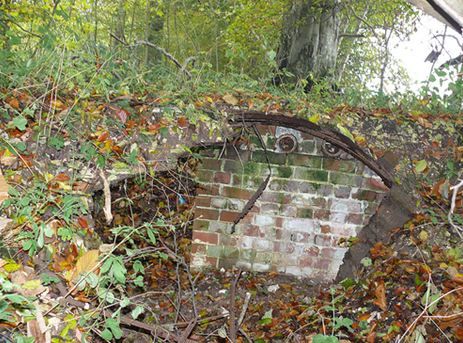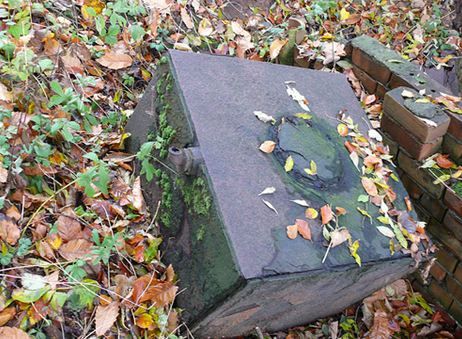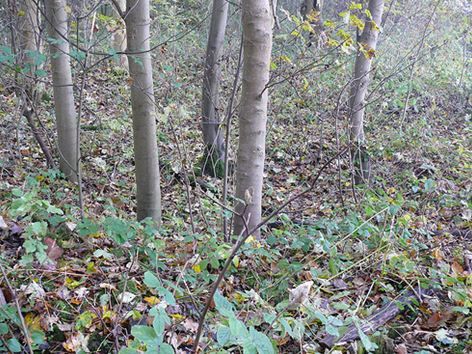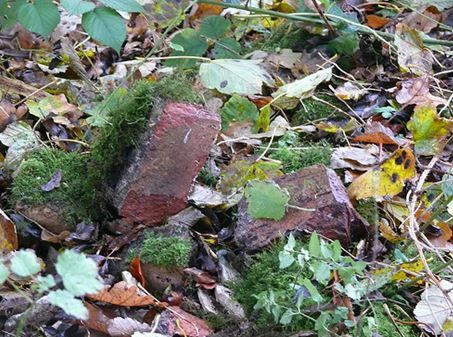The village of Bainton is 6 miles south-west of Driffield on the A614 road.
| Name | Occupation | Posted from | Until |
|---|---|---|---|
| Sergeant David Fletcher Byass | Farmer |
Unknown | 03 Dec 1944 |
| Lieutenant Frank Fletcher Byass | Farmer |
Unknown | 1941 |
| Corporal Harold Wilson Barrett | Agricultural engineer |
Unknown | 03 Dec 1944 |
| Private Thomas Fletcher Byass | Farmer |
Unknown | Unknown |
| Private John Topham Elgey | Farmer |
Unknown | Unknown |
| Private James Angus Elgey | Farmer |
Unknown | 03 Dec 1944 |
| Private Wilfred Simpson | Corn merchant |
Unknown | Unknown |
| Private Thomas Holtby Stocks | Farmer |
Unknown | 03 Dec 1944 |
Typical of a lot of East Yorkshire OBs this one was built just 6 feet from a public footpath. We also found that the depth of the OB was very shallow with only around a foot of earth to cover the entire structure. The escape tunnel exited the OB and ran to the edge of the woodland.
It is estimated that from the entry shaft to the escape exit was only around 40 feet. The main chamber, with two side brick built end walls has collapsed and was approximately 15 feet long and 9 feet wide. The escape tunnel has collapsed and gone as is the entry shaft which may have been wood lined as no brickwork was seen.
A water tank was still in situ with a pipe leading from it into the OB. The remains of an explosive store or what appears to be the explosive store were found west of the OB.
An OP did exist as a one man fox hole near to the main road. No remains could be found.
We came across a structure that had been brick built and a large depression was evident in the ground. Alan Williamson in his book “East Ridings Secret Resistance 2004” states that the explosive store was Stanton type shelter built, we could find no evidence for concrete sections but did find a lot of bricks with mortar in the same style as the OB bricks. It can only be surmised that this is the explosive store recorded and that the concrete sections that are heavily involved in the construction process of a Stanton type shelter were either blown apart and destroyed or moved off site or are covered by woodland debris and the heavy moss that covers the area. We could not find any reason for the abundance of brickwork and the depression.
Bainton Patrol
The Patrol would mostly of have military targets in the area. To the north east was RAF Driffield, just less than 3 miles from the Airfield where a number of Bomber Command Squadrons flew from. Southeast was RAF Leconfield although almost 8 miles away was said to have been a training target of the Patrol. Leconfield was home to Bomber command Squadrons and for a short time Fighter Squadrons. Also southeast of the Patrol was RAF Hutton Cranswick, a lot nearer than Leconfield and was used by Fighter Squadrons.
Although listed in the Patrol targets are airfields it is thought that they were to watch the important cross roads of the A614 and B1248. We checked this within the OP location and at no time could the crossroads be observed or from any location in the tree line.
The Scarborough-Bridlington-Hull railway line also the the Scarborough to York railway. There was also a main railway junction at Great Driffield that would be a Patrol target.
The main roads from the coast to the east that cross the area and over the Wolds. The military thinking was the Patrols were to be able to control/disrupt the movement across the countryside preventing the German invasion forces mounting a quick strike west to take York and the surrounding airfields.
Nothing has been found on the Patrol training, but the Patrol was just over 3 miles from the Middleton on the Wolds County HQ and training ground so it would be safe to assume that they trained there.
The Sergeant or original leader Frank Byass may have gone to Coleshill House for specialist courses. This altered during the war with the trainers coming out to the Patrols due to distance and time.
Weapons issued included; 9mm revolvers, .38 Smith & Wesson or .45 Colt .22 sniper rifle either Remington or Winchester, Thompson Machine Gun later Sten gun, Fairbairn Sykes Knives and homemade knuckle dusters.
The Group Commanding Officer was Lieutenant Frank Byass from Westfield Farm, Bainton. He was the Bainton Patrol's original leader before restructuring the Auxiliary Units.
TNA ref WO199/3389
Hancock data held at B.R.A
1939 Register
Andy Gwynne
East Ridings Secret Resistance by Alan Williamson



